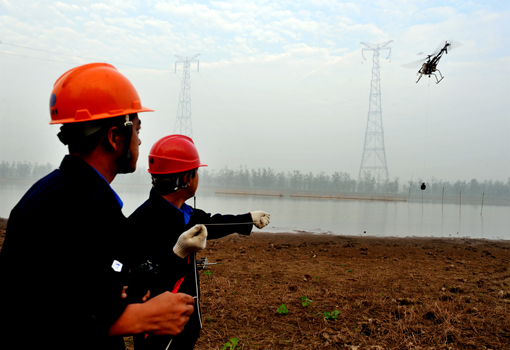|

The Rotorcraft UAVs Performing UHV Transmission Line Stringing Task above the Yangtze River
Photo Provide by Jiangsu Power Transmission & Transformation Corporation |
The Rotorcraft UAVs (unmanned aircraft vehicles) developed by Shenyang Institute of Automation (SIA), Chinese Academy of Sciences (CAS) accomplished the transmission line stringing task across the Yangtze River for the ±800 kV UHV DC transmission line between the city of Chibi and Wulin county in Hubei province on September 29. Domestically, it is the first time for the rotorcraft UAVs to finish such a live construction near an UHV DC transmission line when the waterway was kept open for transportation during the operation.
On the Chibi side of the river, there was heavy fog in the early morning of the day, and the visibility was no more than 200 meters. The rotorcraft UAVs was going to take off from the site here.
The order was made on 7 a.m. and the rotorcraft UAVs took off with the pulling rope. Getting the cable fixed to the power transmission tower on the Chibi side, the rotorcraft UAVs flew towards the tower on the Wulin side, aligned itself to the top of the tower, and fixed the pulling rope to the tower while flying in the air.
On 7:29 a.m., the rotorcraft UAVs automatically returned to the takeoff site. The whole process lasted less than 30 minutes, with the overall flying range of about 5 kilometers. The span between the two power transmission towers was about 2 kilometers.
Technical personnel from Jiangsu Power Transmission & Transformation Corporation participated in the operation. According to the project leader from the company, through the operation the rotorcraft UAVs displayed high speed and accurate positioning in pulling the pulling rope. And it is the first time in China for such a vehicle to reliably finish line stringing task near an UHV transmission line when the visibility is extremely low.
Compared with the towing ship stringing method, by using the rotorcraft UAVs, there’s no need to block the waterway, and the direct input of operation can be cut by over 500,000 RMB (about 78,338 USD) while the construction efficiency enhanced by more than 100%. Additionally, flight approval and scheduling will be needed when using traditional manned helicopter in line stringing, and there will be special demand on the weather and environment. Compared with traditional method, the rotorcraft UAVs operation can save cost by around 200,000 RMB (about 31,335 USD), and the construction efficiency can be increased by over 50%. Besides, the security of personnel can be guaranteed because there is no one on the aircraft vehicle.